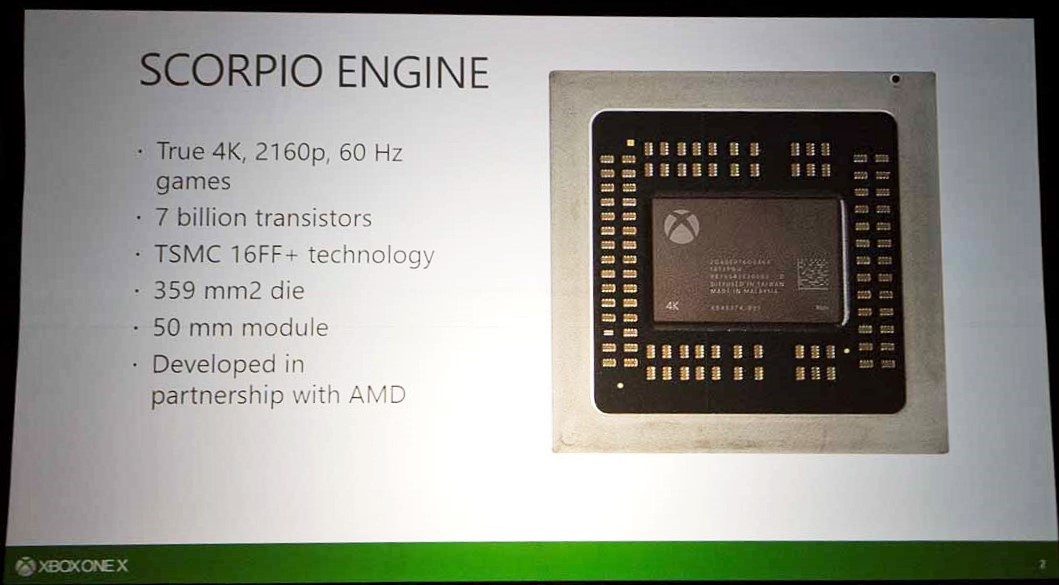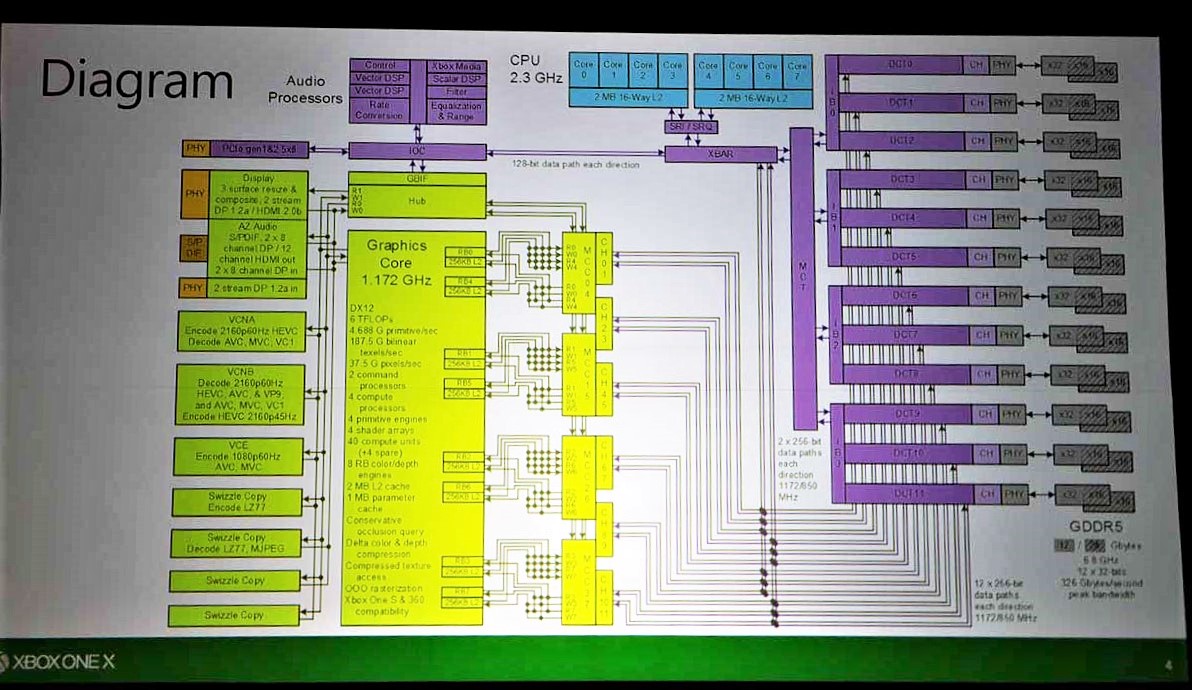Microsoft Details Xbox One X Scorpio Engine SoC
As the release date for Microsoft’s Xbox One X console approaches, the company is opening up about the details of the Xbox One X—the new top of the Xbox One product stack. Today at the Hot Chips conference, the company released schematics and details about the internal workings of the SoC that is set to power the upcoming 4K-ready gaming console.
We already knew much of what the company discussed at the Hot Chips presentation, including the core count; clock speed; and bandwidth specifications of the CPU, GPU, and memory used in the system, but now we know how the components interact with each other.
Microsoft first revealed the Xbox One X, then known only as Project Scorpio, during the company’s E3 2016 conference. In what appeared to be a direct response to Sony’s PlayStation 4 Pro console, Microsoft announced that the next iteration of Xbox One console would boast 6TFlops of floating point performance, which would enable it to support native 4K gaming and virtual reality. The company said that the console would be available before the end of 2017.
In April, Microsoft released some of the basic hardware specs for project Scorpio, revealing that the console would feature an AMD SoC with eight CPU cores and 40 GPU compute units paired with 12GB of GDDR5 memory that provides 326GB/s of memory bandwidth. Microsoft also revealed that the console would include a 4K UHD Blu-ray player and a 1TB 2.5” storage drive.
Then, at Microsoft’s E3 2017 press conference, we learned that the device would be known as the Xbox One X and that it would boast a 384-bit memory bus (up from 256-bit). Microsoft also revealed that the new console wouldn’t include the 32MB of embedded eSRAM cache memory that current Xbox One and Xbox One S consoles offer, although it didn’t explain why.
Scropio: More Than Just A Codename
When Microsoft first announced the Xbox One X, it referred to the console by its internal code name, Project Scorpio. The company walked back the Scorpio moniker somewhat when it announced the official console name, but the company didn’t let go of the "Scorpio" title altogether. At the Gamescom conference in Germany, Microsoft revealed the Xbox One X Project Scorpio limited edition console, which includes the name Project Scorpio emblazoned across the front. But as it turns out, all Xbox One X consoles have a little bit of Scorpio in them. Microsoft called the system-on-chip (SoC) that powers the new console the Scorpio Engine.
The Scorpio Engine is a monster of an SoC developed by AMD, featuring a 359mm2 die with seven billion transistors built on TSMC’s 16nm FinFETT+ technology. The GPU compute units (the yellow section of the layout) consume most of the large die’s surface area. The Scorpio Engine’s GPU components include four shader arrays that each offer 11 compute units. Microsoft said that one compute unit per shader array is left inactive to compensate for yield problems that may occur.
Get Tom's Hardware's best news and in-depth reviews, straight to your inbox.
The right side of the SoC die features the two four-core 2.3GHz CPU clusters (represented in dark green on the diagram). A pair of cache controllers flanks each CPU cluster. Twelve GDDR5 memory controllers line the top, bottom, and right edges of the SoC. The retail Xbox One X features 12GB of memory. Developer kits offer 2GB per channel for a total of 24GB system memory.
Microsoft said that the Xbox One X’s peak theoretical memory bandwidth is 326GB/s, which is nearly five times that of the Xbox One and Xbox One S. The company said that in testing, it managed to address 285GB/s of the available 326GB/s, but most games won’t use that much. The company noted that the extremely high memory bandwidth allowed it to do away with the 32MB eSRAM cache found in the older Xbox One models.
When Microsoft announced Project Scorpio, the company boasted that the new console would be the first to deliver 6Tflops of 32-bit floating point performance. During the Hot Chips presentation, the company said that it managed to squeeze out “just a hair more than 6Tflops." Each of the 40 compute units can perform 128 floating point operations second. Multiplied by the 1,172MHz core clock, that's a total of 6,000,640 Flops.
Microsoft said it put a lot of effort into optimizing the GPU performance. The Scorpio Engine SoC features firmware and “special hardware” to “integrate support for DX12” and maximize the performance of games that take advantage of Microsoft’s API. The Xbox One X’s performance optimizations extend to the CPU, as well.
The new console features an eight-core Jaguar-derived CPU like the one found in the Xbox One S console, but it operates 31% faster than the previous version. Microsoft said that most of the CPU performance optimizations revolve around memory latency improvements of the main memory controllers (up to 20%). The company attributes the improvement to tripling the available memory channels and increasing the number of main memory banks by a multiple of six. It also credits the rearrangement and enlargement of the TLB cache, and the introduction of a redesigned and larger Page Descriptor Cache, which “caches information about nesting page translations” and improves performance by “up to 4.3%.”
The Xbox One X features a single-chip southbridge design, which provides the reference clock for all the components in the system. The Scorpio Engine SoC interacts directly with the memory, the video outputs, the Ethernet network controller, and the south bridge. The southbridge communicates with the other components in the system, including the USB 3.0 controller, the infrared communication ports, the WiFi adapters for the network and the game controllers, the Blu-ray player, the hard drive, and the flash memory.
Audio and Video Improvements
Microsoft is touting the Xbox One X as a premium 4K gaming and entertainment system for the living room. In addition to offering 4K resolution gameplay, the console also boasts improved video decoding compared to the older Xbox One consoles. The Xbox One X supports 4K 60Hz HEVC (H.265), VP9, and AVC (H.264) video formats. It also offers 10-bit high dynamic range (HDR) HEVC and VP9 playback. The Xbox One X also supports 4K 60Hz HEVC video encoding for DVR capture and game streaming.
The Xbox One X features support for 4K, 64-bit display output over the DP 1.2a / HDMI 2.0b protocol. The HDMI port also supports HDCP 2.2 and two-steam MST, which opens the doors for additional display support—a necessary feature if Microsoft ever jumps into VR on the Xbox One X. The upcoming console also includes eight custom audio processors that support spatial surround sound audio, which would also play a big role in VR support. Microsoft said a new firmware update would add spatial surround support to the Xbox One S, too.
Pre-Order Now
Microsoft is about to shake up the console gaming world with the most powerful game console ever built. The Xbox One X is now available for pre-order for a whopping $499, and the first shipments will land in the hands of eager gamers on November 7.
Kevin Carbotte is a contributing writer for Tom's Hardware who primarily covers VR and AR hardware. He has been writing for us for more than four years.
-
AnimeMania The Xbox One X might help widen the appeal of HDR and Freesync as TV and monitor features. It might even encourage Microsoft to fix their HDR support in Windows 10.Reply -
hdmark i think its been said and ive been trying to find the answer. but these specs would put it somewhere around a gtx 1080 for graphics power right? I know that consoles can be optimized better but in general, this is between those two? 4k medium settings 60 fps?Reply -
gggplaya Reply20090225 said:can you please make APU out of this CPU, pretty please ??
Yea, that GPU setup with a ryzen 4 core/8 thread would make a game changing APU.
20090253 said:i think its been said and ive been trying to find the answer. but these specs would put it somewhere around a gtx 1080 for graphics power right? I know that consoles can be optimized better but in general, this is between those two? 4k medium settings 60 fps?
No the 1080 is about 9 teraflops. The ScorpioX would be slightly worse than the GTX1070 in performance. However, since it's a console developers can better optimize the code to match the console perfectly, making better use of the teraflops it has.
-
AgentLozen ReplyChaosmassive said:can you please make APU out of this CPU, pretty please ??
The Scorpio SoC wouldn't make a good APU. It's specifically optimized for console performance. In order to stay completely compatible with the XBox One, it needs to have an architecture that's very similar to the original XBox One from 2013. Console hardware stays on the console for good reason.
For a PC you would get better results from an APU built with Ryzen cores and a Vega derived GPU. Architecturally, it would be far more modernized and more appropriate for a Windows environment.
On the other hand it would be neat if you could build a PC with the Scorpio SoC PCI-e card. You could virtualize an XBox OneX environment in Windows and play XBox games natively on your PC. Any calculations unique to the XBox One could be performed on the PCI-e card and the rest of the work could be done on components you already have on your PC. THAT would be cool. -
marnox Since this is TH and the price is comparable to a single 1070 right now, any estimates how good it is at Ethereum mining? :)Reply -
marnox Since this is Toms (and it's about equally expensive as a 1070 right now), how good is it at Ethereum mining? :)Reply -
TJ Hooker GPU specs put it on par with an RX 580. RX 580 has less compute units (36 vs 40) but higher frequency, so they both end up with about 6 TFLOPS compute performance. Xbox has higher memory bandwidth (and more memory), but it's shared between CPU and GPU. One shouldn't compare the FLOPS between AMD and Nvidia GPUs and conclude it is equivalent to a 1070; AMD cards always have higher FLOPS than Nvidia cards with equivalent gaming performance.Reply
In other words, the only way it's going to get 4K 60 fps is with many compromises to graphics settings.




